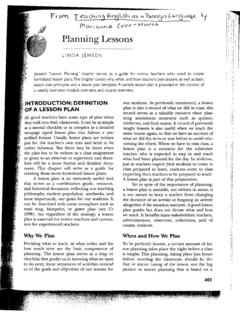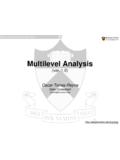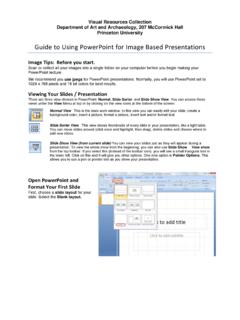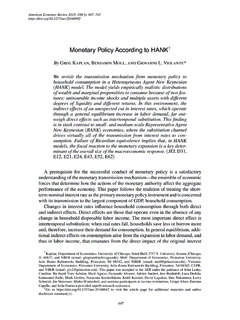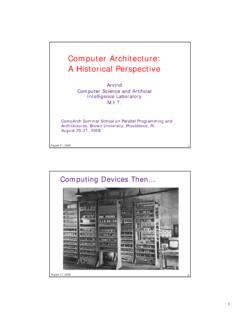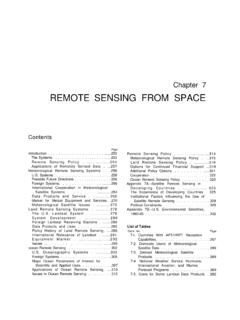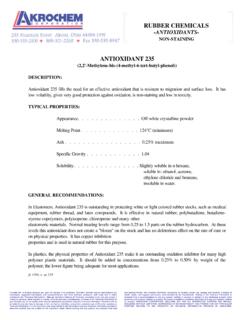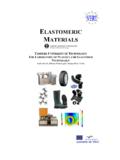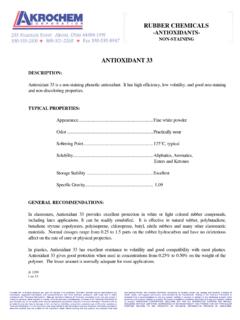Transcription of HOME DRUG INFUSION THERAPY EQUIPMENT AND …
1 Chapter 3 home drug INFUSION THERAPYEQUIPMENT AND SERVICESC ontentsPageOverview..45 Introduction ..45 Summaryof Conclusions..45 EQUIPMENT ..46 Vascular Access Devices..46 INFUSION Devices..49 Techniques and Supplies..51 Services and Staffing .. 55 Patient Screening and Assessment..58 Ongoing HDIT Services..61 BoxesBoxPage3-A. Aseptic Technique ..533-B. Controversy Over Catheter Flushing Methods..553-C. Staffing and Organization of home drug INFUSION THERAPY Services:Two Contrasting Models ..573-D. Patient Screening Criteria for One home Intravenous (IV) AntibioticTherapy Program..583-E. Screening Criteria for home Transfusion THERAPY Patients .. 613-F. The Peripherally Inserted Central Catheter (PICC Line):New Technology and Nursing Practice.
2 653-G. home Blood Transfusion Services: Special Considerations .. 66 TablesTablePage3-1. Typical Supplies in a Delivery by One Company for Four Types of THERAPY ..523-2. Recommended Routine Frequency of Selected Catheter Maintenance ProceduresPerformed for home INFUSION THERAPY Patients, by Type of Vascular AccessDevice..563-3. Average Number of Nursing Visits Per Week for home INFUSION THERAPY Patients,by Selected Types of Vascular Access Device, Type of THERAPY , and FunctionalStatus of Patient..60 Chapter 3 home drug INFUSION THERAPY EQUIPMENT AND SERVICESO verviewIntroductionThe home INFUSION THERAPY industry today is theproduct of technological and medical advancementsachieved primarily during the past two decades, andit is still evolving in response to continuing changesin both these areas.
3 Twenty years ago, home druginfusion THERAPY (HDIT) without round-the-clocknursing services would have been , programmable INFUSION devices with built-insafety mechanisms and safer, more comfortablevascular access devices that can remain in place forlonger periods of time have enabled even bedriddenpatients on complex therapeutic regimens to as well as EQUIPMENT have advanced, andmany nurses and pharmacists now specialize in theparticular professional skills needed in HDIT ( ,placement of a peripherally inserted central catheter, drug regimen review). But not all HDIT techniquesdemand such a high level of skill. Some ( , simplewound care, drug administration) can be performedby trained family caregiversl or by patients them-selves.
4 This chapter describes the variety of equip-ment and supplies used, the broad range of tech-niques and services involved, and the skilled andnonskilled caregivers who provide HDIT in of ConclusionsThe services and supplies needed for HDIT vary significantly depending on the route ofadministration, type of vascular access de-vice, type of THERAPY , and rate of administra-tion. For example, patients with peripheralvenous access require more ongoing skillednursing visits than patients with central venousaccess. Patients with central access, however,may need more intense training, more earlysupervisory visits, and more phone supportuntil they become comfortable caring for theircatheter and administering their who self-administer antibiotics threetimes a day may require 20 times as manyllintravenous (IV) administration supplies aspatients on continuous- INFUSION antineoplastictherapy or pain INFUSION devices have become in-creasingly sophisticated during the last dec-ade, less expensive gravity drip systems arestill safe and appropriate for many thera-pies.
5 Most antibiotic THERAPY and hydrationtherapy can be delivered via gravity drip orspecial disposable INFUSION devices, providedpatients (or their caregivers) are capable ofoperating these devices. In- home gravity dripsystems often include special devices thatenhance safety and ease of operation by pa-tients. Factors that may necessitate the use ofprogrammable INFUSION pumps include: cogni-tive or functional limitations of patients/caregivers; extremely high or low dose volume;therapies of long or otherwise inconvenientduration; therapies requiring frequent adminis-tration; intraarterial infusions; and need forcarefully controlled rate of some of the specific techniques used inHDIT require the skills of specially trainedregistered nurses (RNs), many tasks can beperformed by the patient or by a family memberwho has been taught the proper techniques bya qualified health professional.
6 However, be-cause Medicare beneficiaries are likely to besicker than other patients and they and theirspouses are more likely to have functionallimitations than younger patients, they aremore likely to need paid assistive services inorder to receive INFUSION THERAPY at home . Ifthe frequency and intensity of professionalservices required by a home INFUSION patient aregreat ( , a functionally disabled patient on a4-dose per day antibiotic regimen who has noinformal caregiver available), a skilled nursingfacility (SNF) or other nonhospital institutionalsetting that offers 24-hour supervision might bea more reasonable alternative to hospitalizationthan traditional home Within the nursing and pharmacy professions, home INFUSION specialization is based primarily1 k MS reW~ the tem f@y ~e@er refers to a mend or family member who assists an HDIT patient in self-care talcs on a nonptid home drug INFUSION THERAPY Under Medicareon experience and has not yet achieved separaterecognition by professional organizations.
7 In-creasing availability of formal training ininfusion THERAPY techniques, however, is ex-panding the pool of qualified personnel. Al-though HDIT providers may occasionally havedifficulty recruiting qualified staff, availableevidence does not suggest a critical shortage ofqualified continual emergence of new HDIT tech-nologies constantly broadens the types ofpatients who can be treated at home andchanges the parameters of service new device involves the use of newtechniques that must be learned by nurses,pharmacists, and patients and caregivers. Somerecently developed technologies have reducedthe amount of skilled nursing interventionrequired for patients at home and made it easierfor patients to self-administer complex two fundamental items of EQUIPMENT used inHDIT are the vascular access device2 (the paththrough which a drug enters the bloodstream) andthe INFUSION device (the means of controlling the rateof an INFUSION ).
8 Advances in vascular access andinfusion technology during the past two decades arewhat have made HDIT possible, and the range ofpatients who can receive THERAPY at home continuesto expand as new technologies Access DevicesTwenty years ago, the most common mode ofparenteral administration was a steel needle insertedinto a vein in the hand or arm (peripheral vein).Today, an increasingly broad array of vascularaccess devices is available, ranging from peripheralcatheters (thin tubes inserted into a hand or forearmvein) to totally implantable catheters that access thecentralmost vein of the body. The type of vascularaccess device used in HDIT has implications forboth the amount of skilled nursing interventionrequired and the nature and extent of certaintherapy-related risks for INFUSION choice of a vascular access device depends onthe drug (s) to be infused, the route of administration,the duration of THERAPY , and the physical condition ofthe patient.
9 Data from a recent survey of specialtyHDIT providers show that peripheral catheters areused most frequently for antibiotic THERAPY , whilecentral catheters are more common for antineoplas-tic THERAPY , pain management, and patients onmultiple therapies (256). Most vascular accessdevices can be used for more than one route ofadministration. For example, tunneled catheters andsubcutaneous ports (see below) can be used forintravenous, intraarterial, epidural, intrathecal, orintraperitoneal administration; and peripheral cathe-ters can be used for intravenous or CathetersMany drugs ( , most antibiotics) can be infusedinto a vein in the arm by way of a small catheterinserted into the blood vessel.
10 Peripheral cathetersare particularly appropriate in patients who requirerelatively short-term THERAPY ( , 1 to 3 weeks) andwhose veins are healthy and can withstand repeatedpunctures (145). Maintenance of peripheral routes ofadministration requires frequent skilled nursingintervention. Although able-bodied patients canoften manage the dressing changes (periodic re-placement of bandages covering the catheter exitsite) with the assistance of family caregivers,3catheter insertion requires professional catheters must be changed frequentlyto prevent swelling and irritation at the entry site thatcan lead to infection. When this is done, the oldcatheter is discarded and a new one inserted, usuallyat a different site in the vein.


